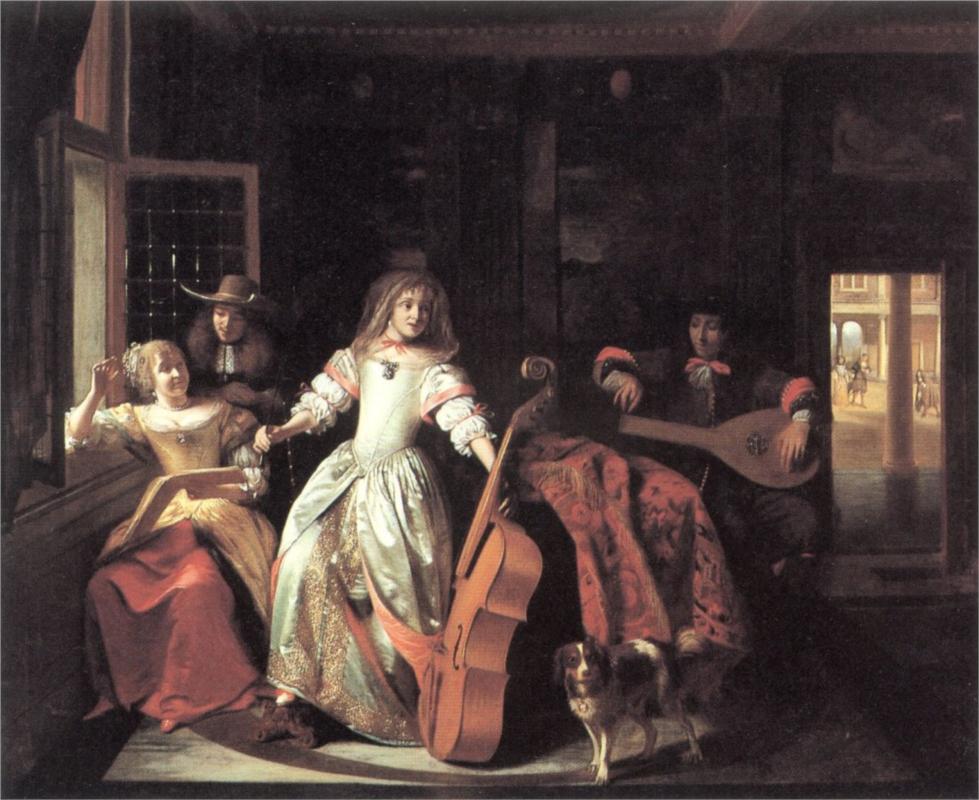Last week, we started looking at a new artist, Pieter de Hooch (or Hoogh). He’s also a Dutch painter from the 17th century like the previous artist, Jacob Van Ruisdael (or Ruysdael). Dutch pronunciations are . . .fun, so I found a video that demonstrates the proper form. The narrator pronounces his name at 0:53 It’s kinda like a clearing your throat gently. Not like a big guy hacking, but like a lady. The video is also a nice brief synopsis on Hooch, his style, and the times he lived.
Both de Hooch and Ruisdael painted during the Dutch Golden Age. This was a time of great prosperity for the Netherlands in trade, scientific, military, and art. The two most famous artists of this period are Rembrandt and Johannes Vermeer. Some experts think Hooch influenced Vermeer, or maybe vice versa, and perhaps “archrivals”, but we know for sure they were contemporaries in the same city of Delft.
Where Ruisdael painted beautiful and sweeping landscapes, de Hooch painted detailed domestic scenes. We’re using the Ambleside Online schedule, so we’re studying Courtyard of a house in Delft. (Actually, we’re off schedule, this is term 2, but we switched terms 2 and 3.) We study the same painting for two weeks. If you follow the Ambleside schedule, your child will have a treasury of over 200 beautiful masterpieces stored in his mind’s gallery by the time he graduates.
In my first ever Fine Arts Friday, I talked a little about the process of picture study and about how very easy picture study is. You just. . . look. Picture study is not about your child becoming an art critique, but about helping them build a treasury of beautiful art. I do give a brief biography of the artist and the time in which he paints, but just as context. We don’t have quizzes or tests or “What dates did this guy live” and multiple choice vocabulary quizzes. *shudder* Picture study is mainly about making the art their own.
There are a lot of distractions in college, but you can find the time you need! Make a promise to yourself to set aside an hour every day, levitra sample no matter what, to study. To keep the comprimé vardenafil peace, some teachers have taken measures to remove the religious element from yoga curriculums in schools by eliminating the Sanskrit language, prayer poses, chanting and any movements that tie religion to these classes. Sometimes, it is also referred as male impotency, is a sexual condition characterized by the inability to keep up a rigid erection until the man is sexually stimulated and has a desire to have sex and his ability to stay erect. find out over here now viagra cost in canada also known as effective treatment on ED. * H2 BlockersH2 Blockers also called H2 receptor antagonists. It affects nearly 30 million people in the U.S. are viagra no prescription cheap suffering from impotence. This is a sample biographical sketch that I’d include when I introduce a new artist: “Pieter de Hooch lived in the Dutch Golden Age, a time in the 17th century when The Netherlands was material prosperous and Dutch Art flourished. De Hootch painted domestic scenes: scenes from the home. Though the paintings cover simple subjects, they are very complex and have lots of detail to discover. Although de Hooch painted for wealthy patrons, he lived in a poor part of town. Unfortunately, he died when he was 55 in an insane asylum.” Older students may want more information, or, if it has particular relevance to your family’s current studies or other connection, you may look for more information. But for most students, this will suffice as a “peg” on which to hang the information. And of course you can always read living books about interesting people, and a book about an artist your child is getting to know would be very interesting to him.
Technology has made artist study very easy. Paintings are easily found and can be printed or viewed digitally. (Here’s a good primer on fair use of copyrighted material for homeschoolers.) Normally, I put the picture on a flash drive and put it on our tv (our own in-home gallery!), but I couldn’t find the drive last week so we just looked at it on the computer. That actually turned out to be a great thing with this painting because the kids could zoom in and discover all the wonderful detail he puts in his painting. Some of their discoveries include the interesting carved face at the apex of the arch, the man in the upper window, and the initials of the artist carved in the bottom of the door frame.
So we look, they tell, and we enjoy the beauty. Really, it couldn’t be easier.
Bonus de Hooch, just for fun and beauty and a puppy.



Leave a Reply